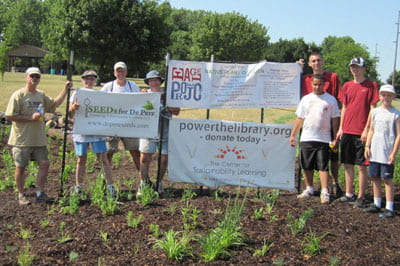 In another fantastic example of UW-Green Bay faculty, staff, alumni and community collaboration this summer, Professor Emeritus Bill Niedzwiedz worked with high school student George Lepak on his Boy Scout service project for the rank of Eagle Scout and helped beautify a local community destination.
In another fantastic example of UW-Green Bay faculty, staff, alumni and community collaboration this summer, Professor Emeritus Bill Niedzwiedz worked with high school student George Lepak on his Boy Scout service project for the rank of Eagle Scout and helped beautify a local community destination.
The 5,000 square foot native plant garden is located at Voyageur Park in De Pere (adjacent to the Fox River Trail) and behind the Kress Family Library. Niedzwiedz and Lepak have been working since January 2012 on germinating and growing native plants, with seeds acquired from Prairie Nursery, owned and founded by Neil Diboll a 1978 UW-Green Bay graduate. (See feature story on Neil Diboll.)
Using his expertise in the fields of environmental planning and conservation design (UWGB), and his association with the De Pere Greenhouse (co-owner), Niedzwiedz helped Lepak select plants, design a native garden, germinate plant seeds, transplant plants, and plant the garden.
On June 23 and 24, Lepak and fellow boy scouts prepared the garden site (e.g., sod cutting, spreading topsoil). On two hot days at the end of June, Niedzwiedz and Lepak along with a group of 30 people including boy scouts, community members and family and friends, planted about 2,000 native plants at the garden site. A six-foot perimeter of no-mow grass will be planted around the garden this fall.
Click thumbnails to enter slideshow view.












Lepak (the son of Susan Gallagher-Lepak, associate professor of Nursing at UW-Green Bay) prepared the project proposal and submitted it for approval to the Bay Lakes Boy Scout Council. He submitted the project to the city of De Pere and received a community service grant to purchase the plant seeds. The project was also endorsed and supported by SEEDS for De Pere and the Sustainability Learning Center at the Kress Family Library.
You can view more photos on George Lepak’s flickr gallery – click here. A time-lapse video of the first day of planting can be viewed at the link below. The time-lapse video consists of still images (one image per minute collected over about 10 hours) and compressed to 90 seconds in video format. See video.

